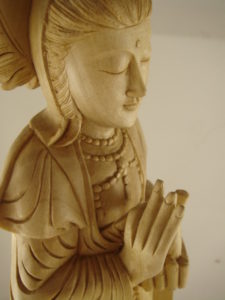Practice Circle: Stay Close to Your Resentment
 One of the interesting things about working with the Tibetan Lojong slogans is the way they so often seem strangely counterintuitive. The slogan we’ll be working with this week at Practice Circle is a good example: “Stay Close to Your Resentment.”
One of the interesting things about working with the Tibetan Lojong slogans is the way they so often seem strangely counterintuitive. The slogan we’ll be working with this week at Practice Circle is a good example: “Stay Close to Your Resentment.”
What? As good Buddhists, aren’t we supposed to be releasing our clinging to illusory notions of self and other that lead to emotions like resentment? Why would I want to hang around with a nasty feeling like that? How would I even go about being “close” to resentment anyway, and what possible good would it do?
“Stay Close to Your Resentment” is one of the slogans grouped under the sixth point of mind training, which Norman Fischer renders as, “Living with Ease in a Crazy World.” That’s what we all want to be able to do; maybe that’s why we practice meditation and other techniques. But we usually conceive of the craziness as being out there in the world, where other people can be so painfully unpredictable and certainly uncontrollable.
As a result, we don’t often reflect on how much of our suffering results from our own craziness: our reactivity, our insistence on having our own way and our agitated thoughts, words and behaviors when we can’t. Then, of course, we typically beat ourselves up for behaving so unskillfully and wish we could drive the craziness away. One of the continual themes of the Lojong slogans, however, is that everything in our life can be an opportunity for dharma practice, especially those moments when we don’t feel very buddha-like. Rather than react with aversion when strong feelings arise, what if we were to stay close to them, get to know them, even try making friends?
One of the reasons mindfulness teachers love to recite the Coleman Barks /Rumi poem, The Guest House, is that it makes this point so beautifully:
The dark thought, the shame, the malice,
meet them at the door laughing, and invite them in.Be grateful for whoever comes,
because each has been sent
as a guide from beyond.
All of our emotions, even the painful and seemingly unproductive ones, are here for a reason. They are the body reacting to the situation that it’s in, a reaction that emerges from the wisdom encoded in every cell and every molecule. Even should we become so enlightened that we are no longer bothered by strong reactivity of our own (and who do you know who has?), our natural compassion will acquaint us with the suffering of those around us. If we learn to listen carefully to our bodies, we can glimpse the sometimes surprising messages strong feelings are bringing to us. But first, we have to practice getting up close and personal with them.
Fischer writes,
Think about it. What is resentment, after all? What happens when you stop projecting outwardly (because we are always resentful of something or someone out there, even if it is life, or ourselves, as if we were outside ourselves) and turn around to look at the resentment face-to-face to find out what it is? What color is resentment? Is it green? Is it purple? Is it pink? Is it white? Is it black? Is it tall? Is it short? Is it fat? Is it thin? What happens when you investigate? Can you look resentment in the face and see what it is? Can you feel the feelings, watch the thinking, see your actions unfold?
The investigation of resentment and of all afflictive emotions is the most powerful and the most beneficial of all practices. The peace that we are all seeking is less than half as good as the investigation of resentment, anger, greed, fear and so on. These are basic visceral, human emotions. They are our great treasure. So we should always stay close when they arise in us, so we can meditate on them.
When Practice Circle meets again this Sunday, July 9 at 6 Pacific, 8 Central and 9 Eastern time, we’ll share an exploration of this great treasure. I hope you’ll join us! To join our video conference group, simply follow this link: https://zoom.us/j/968569855
